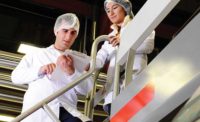Proper PPE combats high rate of injuries in food and beverage manufacturing

Amorn Suriyan / iStock / Getty Images Plus
The food and beverage industry is the third largest manufacturing sector in the U.S.1, employing just about 1.7 million workers2 across nearly 40,000 processing plants3. Given the multitude of plants and employees, hazards can be found at every turn.
The industry has one of the highest rates4 of job-related injuries and illnesses. With so many hazards including loud machinery, cutting and chopping, harsh cleaning chemicals and refrigerants, and wet surfaces, it’s important to have a game plan for safety. Even a small error in the manufacturing processes can impact a worker’s safety and cause a huge hit to a business’s reputation.
Food and beverage encompasses multiple manufacturing sectors, with meat processing being the largest industry group based on sales, value added and employment, according to the United States Department of Agriculture.
Personal protective equipment (PPE) is an easy and effective method to ensure the safety of employees and the product they handle. When appropriate protective equipment is chosen for employees and worn the right way, it can help significantly reduce the risk of injuries, leading to reduced losses in terms of time, money and overall productivity.
In food and beverage manufacturing, there is a distinct hazard that extends beyond safeguarding workers – protecting the product from contamination. By fostering a safety-oriented culture and equipping workers with comprehensive PPE, you can help prevent contamination issues and maintain seamless operations. This may entail implementing head-to-toe PPE measures to contribute to the safety of employees throughout the entire process.
Respiratory hazards
The food and beverage industry relies heavily on refrigeration, often employing ammonia-based systems that pose risks to the lungs, skin and eyes. Refrigeration creates cold and damp environments that can potentially lead to safety hazards. When working closely with refrigeration systems, it is best to wear a mix of protective gear like safety eyewear, nitrile gloves designed for safe food handling, and a high-quality mask to help keep dangerous particles from being inhaled. Given rapid and sudden temperature changes, it’s important to look for safety eyewear with an anti-fog coating to have a clear line of vision when on the plant floor. By providing PPE for cold handling, it gives workers confidence to perform their daily job duties with lowered risk of injury.
Refrigeration systems aren’t the only cause for respiratory hazards. It’s important for food and beverage plants to have a high level of sterility which can mean using potent cleaning agents to clean machinery or workstations. Therefore, masks and face shields are an important form of PPE in this industry. You’ll want to find one that fits comfortably and molds to each workers’ face to ensure they are able to wear them properly, all day.
Fall hazards
With all of the moving parts in the food and beverage industry, slips, trips and falls5 are among the most common causes of injury for workers. In fact, they are responsible for 18% of nonfatal injuries6 in the workplace resulting in days away from work. Many of these incidents in food and beverage can be attributed to the high volume of liquids, whether it be cleaning agents or water, workers are regularly exposed to wet surfaces. Proper footwear while on the plant floor is crucial to provide traction and prevent injuries. A clear path for moving about the facility is also key to prevent trips. Make sure wires, cables, and even machines are out of the way on major walkways and through doorways.
Hearing hazards
Surprisingly, there are many hearing hazards in the food and beverage industry. Many people think about cutting and chopping but don’t realize how loud processing machines can be. Conveyor belts alone can range from 90 decibels A (dBA) to 100dBA. OSHA’s permissible exposure limit is 90dBA for workers for an 8-hour day. However, if these machines operate throughout an entire shift, workers can be exposed to noise levels higher than the maximum limit of 90dBA, causing permanent hearing damage.
The good news is there is a wide range of ear protection products to choose from that help cut down on harmful noise. When choosing hearing protection, workers should consider factors such as noise reduction rating, disposability, reusability, moldability, firmness and if they are corded or not. In some cases, over-the-ear protection like earmuffs may be needed if the noise levels are exceptionally high but the need for communication is still important. In food and beverage, it’s important to opt for metal detectable earplugs as if they are lost in the production process, they can be found through metal detectors that most manufacturing facilities use.
Enhance your safety plan
While we couldn’t touch on every single hazard in the food and beverage industry, there are still additional steps you can take to enhance your safety plan even more. Much of what was discussed is how PPE can help to cut down on injuries and illnesses while on the job. You can further your safety protocols beyond PPE with appropriate trainings, equipment demonstrations, following OSHA guidelines, keeping up with the latest standards, and ensuring regular maintenance on machines, just to name a few. Another way to maximize safety with PPE is to perform PPE inspections. By checking your workers’ PPE, you can see what gear they may be missing and identify what gear might need replacement.
In the end, providing appropriate PPE that properly fits each employee is the employer's responsibility. Putting all these safety solutions into play can help create a culture of safety and encourage employees to not only personally ensure their own safety, but also help their fellow peers stay safe at work.
Sources:
- https://www.nist.gov/el/applied-economics-office/manufacturing/total-us-manufacturing/manufacturing-economy/total-us#:~:text=Types%20of%20Goods%20Produced,2.9%20from%20AMS%20100%2D49.
- https://www.bls.gov/oes/current/naics3_311000.htm
- https://www.ers.usda.gov/topics/food-markets-prices/processing-marketing/manufacturing/
- https://www.bls.gov/opub/ted/2019/injury-and-illness-rates-higher-in-special-food-services-than-in-broader-food-services-industry.htm
- https://www.graphicproducts.com/articles/hazards-in-the-food-processing-industry/
- https://www.cdc.gov/niosh/injury/fastfacts.html
Looking for a reprint of this article?
From high-res PDFs to custom plaques, order your copy today!








.jpg?t=1721257160)